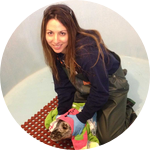About This Project
The waters of the western New York Bight are located just outside the city of Manhattan, NY. Humpback whale sightings in this area appear to be increasing, and due to the presence of high human activity, it has become necessary to conduct an investigation. This study will analyze trends in sightings and distribution, identify relationships with environmental variables, and document seasonal residence. The results will identify critical areas, providing evidence towards the need for management.
Ask the Scientists
Join The DiscussionWhat is the context of this research?
Through my work at the Marine Mammal Stranding Center in NJ, I became greatly familiar with the local marine mammals. I began to notice that there were increasing reports of humpback whales in the western New York Bight (NYB) from May to October. Unfortunately most research in this area is concentrated further east and offshore. When I entered graduate school, I knew that I wanted to change that. Previous studies in the coastal Mid-Atlantic have focused mainly on Virginia, and reported that humpback whale distribution was sporadic and occurred primarily during the winter (Swingle, et al., 1993). Other recent available data comes from whale watching vessels and anecdotal reports. A formal study is necessary to scientifically document these whales, and provide a baseline for future research.
What is the significance of this project?
Are humpback whale sightings in the western NYB increasing? This is the main focus of this research. The answer to this question will set the stage for future research on humpback whales in this area. Why is this important? Because the western NYB is an area of the highest vessel activity on the East Coast of the United States. It is where major shipping lanes to the Port of NY and NJ converge, along with additional commercial and recreational fishing traffic. Increasing numbers of humpback whales could mean an increase in human-wildlife conflict. Furthermore, documenting sighting locations and understanding what environmental variables drive their distribution will help in identifying critical areas for future management.
What are the goals of the project?
Most significantly, the goal of this project is to highlight the increasing presence of humpback whales in the western NYB. To answer this question, field work will be performed from June through October aboard a whale watching vessel in Queens, NY. On-board methods will include documenting the first and last location of each humpback whale sighting and taking photographs for individual identification. Statistical analyses will be performed on new and historic data to analyze trends in sightings, and determine whether GPS locations are clustered in areas of specific sea surface temperature or depth. Additionally, residence times of individual whales will be determined by the time between the first and last sightings of each individual within the field season.
Budget
The most significant portion of this budget will go towards travel expenses. Living expenses in the NYC area are very expensive, so I will be commuting from my home in New Jersey to save money. Travel expenses include the costs of fuel and tolls for commuting to the research vessel for 5 months (bridge and highway tolls cost approximately $30 per day). Equipment expenses include the purchase of a refurbished DSLR camera, a 75-300mm telephoto lens to allow for good quality photos at a distance, and a waterproof handheld marine GPS to record all sighting locations. Any additional funds over and above the budget will be used towards travel expenses to regional and national conferences to present the results of this research. The only external funding would come from my own personal funds.
Endorsed by
Meet the Team
Danielle M Brown
I have lived in New Jersey for my entire life, and I have always been interested in marine mammals. I earned my Bachelor's degree in Biology with a minor in Marine Science from Stockton University in 2012, and since then I have been lucky enough to be involved in much of the marine mammal work in the state of New Jersey. I have performed photo-identification research on bottlenose dolphins in Cape May, NJ and worked full-time for three years at the Marine Mammal Stranding Center as a Field Stranding Technician. In 2015, I made the significant decision to attend Graduate School at George Mason University. I am currently in the Master's program in Environmental Science and Policy with Dr. Chris Parsons, an internationally known marine mammal conservationist, as my advisor. I am using my knowledge and experience to develop a Master's thesis focused on humpback whales in the western portion of the New York Bight, and I am excited to spread the word about the marine mammal biodiversity in the area.
Lab Notes
Nothing posted yet.
Additional Information
Swingle, W. M., Barco, S. G., Pitchford, T. D., Mclellan, W. A., and Pabst, D. A. (1993). Appearance of juvenile humpback whales feeding in the nearshore waters of Virginia. Marine Mammal Science. 9(3):3009-315.Project Backers
- 3Backers
- 3%Funded
- $79Total Donations
- $26.33Average Donation


